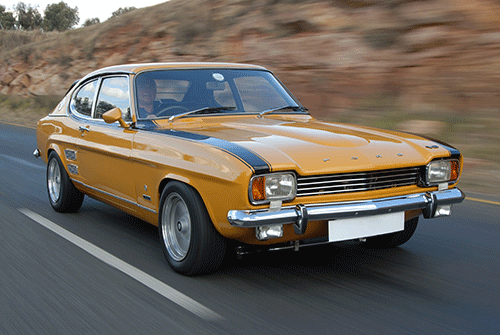Ford Southern Africa has developed and launched several iconic cars for local enthusiasts over the decades. Many of these developments have been unique to the southern African market, building the Ford brand and heritage on our local roads and racetracks. Ford has a rich history in southern Africa, and a legacy of always being in tune with local appetites and trends. So much so that Ford has commissioned and developed many vehicles unique to southern Africa, many of these to defend Ford’s True Blue legendary status on local racetracks, and others to fill gaps uniquely found on the local motoring landscape.
Ford Capri Perana – 1970
The late Basil Green is synonymous with not only the Ford Capri Perana, but also many other Fords from the 1960s and ’70s found on our roads and racetracks. The Perana was a locally developed vehicle that aligned with Ford’s global commitment to its “Total Performance” advertising campaign from the period, and the road cars were officially available through Ford dealerships across the country.
The Capri Perana was particularly renowned for its dominance in South Africa’s Group 5 racing, especially during the 1970 season. That year, Bobby Olthoff, with his Capri Perana V8 Gunston-livery car number Z181, won 13 out of the 14 races.
The Capri Perana is unique in that it is the only Ford factory-sanctioned Capri that was ever fitted with a V8 engine. Here the 5.0-litre Windsor V8 from the Mustang did an impressive job of seeing off the competition. CAR magazine tested one of the road cars at the time and achieved an impressive 0 to 100 km/h acceleration time of 6.7 seconds. Both four-speed manual and three-speed automatic transmissions were available to buyers, although today collectors tend to prefer the manual version over the automatic.
The Capri Perana was identified by its larger wheels and double exhaust pipes, to name but two upgrades. In a car tipping the scales at just below 1 100 kg, with 210kW and 407Nm on tap, the performance was truly overwhelming at the time. The two official exterior body colours were Bright Yellow and Piri Piri Red. Likely because of its on-track success, it turned out to be a hit with the public as well, with Basil Green Motors shifting around 500 road cars. The company also produced Perana versions of the Escort, Cortina and Granada in the Sixties and early Seventies.
Ford Cortina Mk3 bakkie – 1971
Enthusiasts will remember that a few years after the Cortina bakkie was unveiled,
Ford released a limited-edition Cortina bakkie and sedan known as the Springbok edition. These vehicles, painted green and gold, left no doubt about their purpose: showing support for the Springbok team during the 1976 All Blacks tour of South Africa.
Both the sedan and the bakkie featured a gold painted roof and wheels with a pin stripe running along the side of the vehicles. The rest of the car was painted green. The success of the original Cortina bakkie has also proven to be the genesis of the word bakkie in motoring, which is still used by all South Africans to refer to any type of light utility pick-up. The Cortina bakkie idea was then carried over to the Mk4 and 5 versions of the Cortina and it proved to be an exceptionally tough vehicle, with some of them still seen to this day plying their trade.
Ford Cortina XR6
Interceptor – 1981
A performance version of the MK4 Cortina, named the 3.0S, was developed by Ford’s Motorsport division in the late 1970s. It was fitted with the 3.0-litre “Essex” V6 and had uprated and slightly lowered suspension, among other improvements. This car evolved into the better-known Mk5 Cortina XR6. An iconic Ford print ad at the time for the XR6 said: “Buckle in for the drive of your life.”
Celebrating its motorsport successes, the company produced a Team Ford, or “TF”, edition of the Cortina XR6 with distinctive blue pin striping, however, the ultimate development of the Cortina range came in the form of the legendary XR6 Interceptor, another homologation special to allow Ford to go racing. Painted Wild Coral Red, this model stood out from all other Cortina models, replete with its shading slats over the rear window, the small black boot spoiler and the double, four-spoke wheels. If other drivers saw the car approaching in their rear-view mirrors, there was no mistaking it for anything else on the road. Each car’s number was also individually printed at the bottom of the C-pillar and corresponded with the chassis plate.
As with all homologation specials, one of the stand-out features was the engine. The Interceptor’s 3.0-litre V6 featured a set of triple downdraft 42 Weber carburettors and new high-performance exhaust manifolds. One of the internal upgrades to the engine was a more aggressive camshaft. The result was 118kW, a healthy increase over the standard 101kW Essex V6 engines. To aid handling, wider Ronal 13-inch wheels were fitted to these cars.
– Ford South Africa


